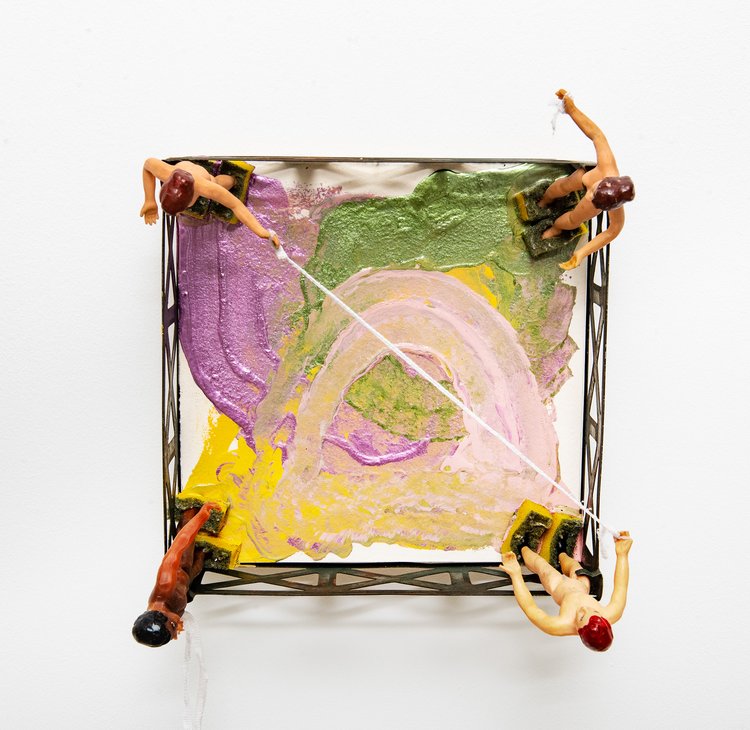EAT SHIT WATCH CRAP
Traces and fractals
Welcome to Huis De Uil, which has been occupied by Messrs Massa and Liekens since 2002. They have left their own mark on the house, without disavowing its original inhabitant, and have invited Christophe Coppens to show new work in this exhibition.
This is the house that Karel Aubroeck built, where he lived and worked. You may know Karel Aubroeck because of his sculptures, which can be found in public spaces throughout Flanders. The reclining woman on the bridge at Temse, the monument to King Albert I in Nieuwpoort, the sculptures for the Yser Tower in Diksmuide: all classic forms, cast in solid bronze or modelled in Flemish clay. Aubroeck’s spirit is inextricably linked with this house, which he expanded with every new, large commission he received. It had all the classical symmetry of an Egyptian temple, after which it was expanded with a museum, then a workshop and, ultimately, an even larger studio and gallery, with its own clay pit.
Eat Shit, Watch Crap is an exhibition about traces. Of a world that continues to outdo itself in terms of the coarseness of its languages and customs. Of the sculptor who is no longer here: his home, remnants of his work, outdated ideals from another era. Of the new occupants: the warm glow of the fireplace, the light, the hospitality. And of the new artist: his work, his ideas, his place in the world.
This exhibition follows a trail that extends from an antechamber (the entrance hall that Aubroeck also liked to call his museum) to the studio to the sculpture gallery. It resembles a sonata, that begins by exposing an idea, which is then developed, only to end with a re-capitulation of that same theme. Every space, every moment, bears its own traces in this .
The wooden female figure in the antechamber bears a trace of the original occupant, engaging in a dialogue with Coppens’s assembled self-portrait, which is centrally hung on the wall. Traces of the current occupants can be found in the fireplace, which has been transferred from the museum to the living room, where it establishes a connection with the fiery-red water basin in the painting at the other end of the room. The small ceramic stones on the red table, the two masks on a pedestal, and the large painting: they refer to the bricks that Aubroeck used to build this house, to Coppens’s large sculptures elsewhere in the exhibition, made using the same technique as the masks, and to the water basins in the sculptures. An antechamber, like an armoury, with trophies and a tapestry.
There are traces of activity in the studio: paint on the walls, on the floors, on the brushes; grime on the mops; the artist’s tools are strewn on the tables. The only thing that seems to be missing is his work. But these self-conceived and produced tools are the work. They seem to be painting without the artist: animism. They point to something that has disappeared (an activity? a painter?). The heads that Coppens uses as paint sponges will meet the same fate. They are masks that refer to Hollywood film props, made to last only as long as it takes to make a film. All that remains are their ceramic eyes.
The sculpture gallery is where the re-capitulation takes place. This is where Coppens’s new sculptures engage in a dialogue with Aubroeck’s works. Above you, in the farthest corner, you can distinguish the remnants of a horse’s head and the king’s head for the Nieuwpoort monument. The answer to this realism can be found in the exaggerated curves of the woman – in a sense she reminds us of the oldest Venus sculptures – who transforms vomit into milk and then water in a closed circuit: another ideal from another era. The body of the reclined man, whose position is similar to that of the woman on the Scheldt bridge just up the road, is covered with an exaggerated number of penises and testicles. These sculptures are hand-sewn and painted: handiwork that is soft in form and matter, contrasting strongly with Aubroeck’s hard monumental work.
The bas-relief (by Aubroeck) on the wall to the left at the rear reveals the inspiration for the small ceramic sculptures in the other rooms, whereas the sewn figures are reflected in the large mirrors that Günther Förg installed on the walls for Jan Hoet’s Ponton 1990. The heterogeneous animals (is it a cow, a sheep, a camel?) contrast with the realism of the horse’s head. Animals as basins, as receptacles of ideas and matter. It is what it is, or so the mirrors assure us.
No re-capitulation without a grand finale. There’s more to that flamingo by the window than meets the eye. Here is the denouement, this is where the loose ends are tied up. Now you understand the strange pink that is so prominently present throughout the exhibition. Instead of fingers, we see only more flamingos on his hands. They are fractals: parts of a larger whole that are similar to that whole. This is a well-known concept from chaos theory. Here some order – or rather: a possible order – is established in the upbeat chaos of this exhibition. The studio that you just saw? It’s a head, of course: the artist’s head. And in that studio? That’s where the heads of the artist multiply like fractals, that each contain that whole. And in that head? Tools that paint, without a work, or artist. Like in a dream.
